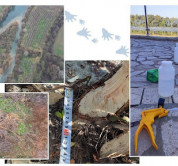
The Eurasian (European) beaver (Castor fiber Linnaeus, 1758) was once widespread in northern and central Europe and Asia, but was heavily hunted for its valuable fur and castoreum (a highly aromatic secretion from the anal glands, which was used in perfumery) to almost complete extinction. At the beginning of the 20th century, only about 1,200 beavers survived in eight relict populations in Europe and Asia (Halley et al. 2012). The species was found on the territory of Bulgaria until the middle of the 19th century.
After the 60s of the 20th century, in many countries in Europe, projects related to its re-introduction (reintroduction) were launched, many of which were successful and the beaver returned with a large part of its range, including Romania. At the same time, the invasive Canadian beaver (Castor canadensis). In our country, the first evidence of its presence was found in 2020 in the area of Rusenski Lom. Since then, traces of his vital activity are regularly noticed in several places along the course of the Dunev River and its tributaries. The aim of the current project is to test innovative methods for monitoring the species such as environmental DNA and detection and mapping of traces of the species using unmanned aerial vehicles. The genetic data for the species will provide information on the origin of the Bulgarian populations, will confirm their belonging to the native species (Castor fiber) and will serve as a scientific basis for declaring it protected.
- IBEI-BAN
Contact person: Maria Kachamakova, maria.n.kachamakova@gmail.com